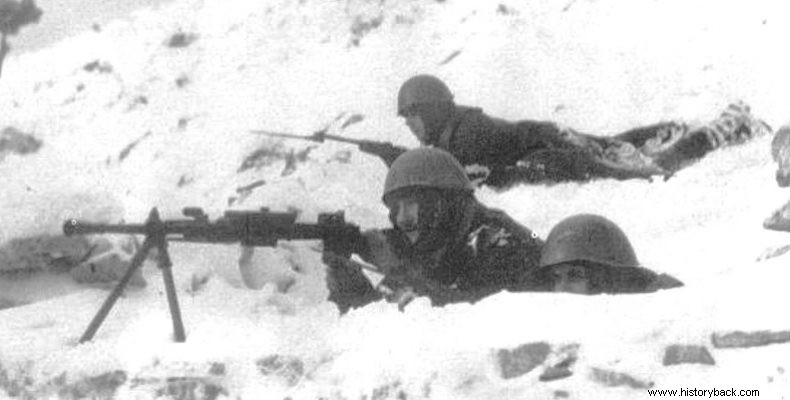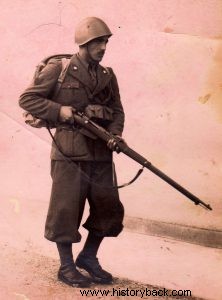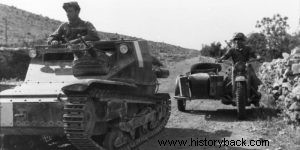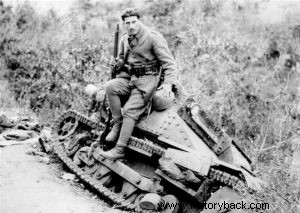
Although today many tend to argue the opposite, Italy in 1940 was a great European power. It wasn't Germany, it wasn't Britain, but it was a great power especially compared to little Greece. The dictator Mussolini had tried to strengthen the Italian army, without much success. The Italian army was far from being a well-tuned, well-trained force. The infantry especially lacked in training, especially in the use of terrain. His attack tactics were of World War I and relied on firepower mainly, and not so much on maneuver, to bend the enemy's resistance.
The bulk of the Italian army, like the other armies after all, consisted of infantry divisions. The Italian Infantry Divisions (IP) that faced the Greek Army in 1940-41 were of the binary type, i.e. they had two infantry regiments, instead of three which was the international norm. They usually supplemented their strength with 2-3 battalions (cohorts, according to fascist terminology) of Blackcoats, either independent or formed into their own regiment (legion, again according to fascist terminology).
The MP had, as a staff, two infantry regiments, each of three battalions, an artillery regiment of three divisions, of four artillery companies each (36 guns), a company of Pioneers, a company of Divivas, an anti-tank company with eight 47 mm guns, a battalion of mortars with 18 (and not 48 as has been wrongly mentioned in the Greek literature) tubes of 81 mm. and other services.
Each regiment had a staff, command platoon, relay platoon, three Infantry Battalions (IP) and in addition an infantry escort artillery with four 65mm guns. 571 horses, 10 motorcycles, 19 bicycles and 44 other vehicles. The armament of the regiment consisted of four 65 mm guns. 54 light mortars of 45 mm. 25 machine guns and 108 machine guns. Its strength was 115 officers, 171 non-commissioned officers and 3,163 enlisted men.
Each infantry battalion had 52 officers, 76 non-commissioned officers and 1,130 enlisted men. The battalion had three infantry companies, heavy weapons company, command platoon, relay platoon, scout platoon, transports. Each company had three platoons, each of two groups only. But each team had two machine guns instead of one in the Greek Army teams. The heavy weapons company had two machine gun platoons, each with 4 machine guns (8 in total) and a light mortar platoon (9 45mm tubes in total).
The "legion" of the Blackcoats had 2-3 "cohorts". Each "cohort" had about 700-750 men, armed with 24 machine guns, 6 machine guns, 9 howitzers of 45 mm. and rifles. The divisional mortar battalion had three companies of 81mm mortars. with 6 pipes per company and had a strength of 530 men. The anti-tank artillery numbered 240 men and had eight 47mm A/T guns. 76 horses, 10 trucks and a bicycle. The divisional artillery regiment had three squadrons, one with 100mm howitzers. and two with 75mm guns. It also had an anti-aircraft squadron with 8 20 mm guns. He presented 2,750 men, together with the corresponding testicles and conjugalities.
The Italian MPs were not all of the same quality. The recruits in northern and central Italy were generally considered better and it is no coincidence that those in Albania all came from these areas. On October 28, 1940 in Albania and Northern Epirus there were:23rd MP "Ferrara", 51st MP "Siena", the Armored Division "Kentauros", the Coastal Group referred to in the Greek literature as "Cavalry Division", the 3rd Mountaineers " Giulia", the 29th MP "Piedmont", the 49th MP "Parma", the 19th MP "Venezia" and the 53rd MP "Arezzo". The first three, together with the Coastal Complex, made up the "Tsamouria" Army Corps, while the others were or were later included in the 26th Army Corps.
The Mountaineer Divisions
The Alpinists were considered an elite body of the Italian army. In 1940 there were 5 Alpinist divisions in the Italian army. A sixth was formed in 1941. The men of these divisions came from the mountainous, alpine regions of northern Italy and were well trained in mountain fighting. The Alpinist divisions had, like the infantry, two regiments of three battalions each and one artillery regiment of six artillery divisions. The difference was that each Mountaineer battalion had an artillery, engineer and service element permanently attached to it. Thus each battalion constituted an autonomous group capable of undertaking autonomous missions.
The division had a staff, headquarters company, two Mountaineer regiments, an artillery regiment, an engineer battalion, a chemical warfare company, two field battalions and services. A platoon of anti-tank guns was also included in the headquarters company. Each regiment also had a headquarters company, to which a flamethrower company and its three battalions were attached. The Mountaineer regiment had 27 machine guns, 81 machine guns, 27 45 mm Brixia light mortars, 12 81 mm mortars. and 27 flamethrowers. The guns were 75mm mounts. This type was the 3rd Alpinist Division "Julia" which tried to split the Greek front in Pindos, at the beginning of the war. The 2nd Alpinist Division "Tritentina", the 4th Alpinist Division "Kunense" and the 5th Pusteria also fought against the Greeks.
The "Centaur" Division
The Italian 131st Armored Division "Centauros" was the first Italian division of this type and together with the 132nd Armored Division "Ariete" constituted the Italian Armored Army Corps. The division had one tank regiment with three divisions, each with 55 tanks, and one mechanized infantry regiment (Versailleurs) of three battalions. It also had an artillery regiment of three divisions, a motorized anti-tank company, a mechanized engineer battalion, an armored wheeled vehicle division, the 5th Versailles motorcyclist company and services.
The division had the 13th, 14th and 15th light tank divisions with CV33/35 tanks armed with one or two 6.5 or 8 mm machine guns. However, the Italian command in Albania – General Praska – he did not use the available tanks in a concentrated manner so that only 1/3 of the available tanks took part in the main Italian attack on Kalpaki.
Italian tankettes were nothing special. However, against the Greeks, who did not have anti-tank weapons, they could make a difference if they were used en masse. Instead Praska dispersed his chariots across the front. In Kalpaki, the Greeks faced them with anti-tank ditches and anti-tank obstacles made of rails, mines (minefields) and at the point of their mandatory passage with mass fire from the Anti-Tank Group formed by the commander of the Greek VIII MP, Lt. Gen. Charalambos Katsimitros, which had two plain 75 mm artillery pieces. an artillery of 105 mm. and four 37mm anti-tank guns 
Italian Alpinist in 1940.

Tankette CV35. It carries two 8mm machine guns

Greek soldier with a captured Italian chariot.
